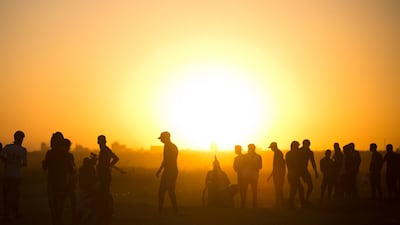Subdued protests took place along the Gaza border on Friday after Hamas agreed to reduce the scale of demonstrations as Egypt seeks to negotiate a ceasefire to end months of deadly confrontation.
Smaller numbers of Palestinians took part in the weekly gathering at the border fences to promote the Great March of Return. There were none of the burning tyres or attempts to scale the wire that had been feature of months of Friday demonstrations.
Cairo has demanded an end to the crippling blockade of the Palestinian territory to secure the ceasefire that would end the weekly cycle of violence.
"The negotiations between the Palestinian factions and Israel by Egyptian mediation are going well," Tallal Abu Zarifa, one of the protest organisers, told The National.
"The demonstrations continue on border areas but with new method in order to alleviate its severity, to stop burning tyres, throwing flamed balloons or approaching the fence.”
He added that the scaling down meant that Israel had no excuse not to participate fully in the Egyptian efforts to negotiate a lasting ceasefire.
Despite the scaled-back demonstrations, Israeli soldiers fired tear gas and live bullets, causing injuries among the protesters along the border areas.
The Palestinian health ministry said that around 32 people were admitted to hospital on Friday, seven of them with live bullet wounds. While dozens of others were treated for tear gas inhalation at the border.
_______________
Read more:
Hamas agrees to end protests along Israel-Gaza border
Israeli army opens probe into killing of Gaza medic
_______________
Speaking at one of the Great March of Return camps east of Gaza city, Khaleel Alhaya, a Hamas official declared that Egypt-led efforts to"break the Israeli siege are close to success".
However, he said the Great March of Return protests would continue as an assertion of the Palestinian's political demands.
Mekhamer Abu Sada, a lecturer of Political science at Al Azhar University, told The National: “Factions in Gaza are trying to stop violent protests in order to prepare for the Egyptian's efforts to approach for a ceasefire, in order to alleviate the blockade".
He added: "The next stage will be a test intentions stage. If Israel is honest in its promise and alleviates the blockade then the protests will stop -- if it is not the protests will come back again stronger than before.”
Named The Great March of Return by Palestinian organisers. the weekly Friday demonstrations began on March 30 this year. Since then, at least 218 Palestinians have been killed by Israeli fire, while hundreds have been maimed by Israeli snipers aiming at their lower limbs.
Mohammed Mosabeh, 17, lost his right leg on May 4 while participating in a protest east of Khuzza area, south of the Gaza Strip.
He told The National that the protests should continue “because we have not reached our goals yet".

